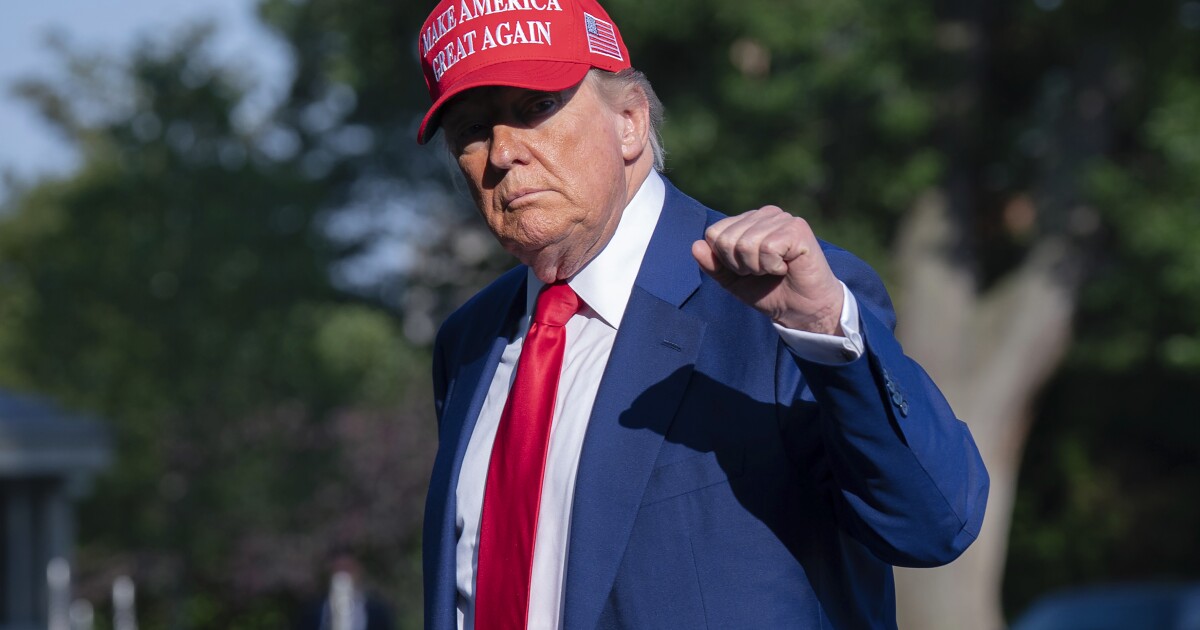Technology
Meta becomes the latest big tech company turning to nuclear power for AI needs
WASHINGTON — Meta has cut a 20-year deal to secure nuclear power to help meet surging demand for artificial intelligence and other computing needs at Facebook’s parent company. The investment with Meta will also expand the output of a Constellation Energy Illinois nuclear plant. The agreement announced Tuesday is just the latest in a string […]

WASHINGTON — Meta has cut a 20-year deal to secure nuclear power to help meet surging demand for artificial intelligence and other computing needs at Facebook’s parent company.
The investment with Meta will also expand the output of a Constellation Energy Illinois nuclear plant.
The agreement announced Tuesday is just the latest in a string of tech-nuclear partnerships as the use of AI expands. Financial details of the agreement were not disclosed.
Constellation’s Clinton Clean Energy Center was actually slated to close in 2017 after years of financial losses but was saved by legislation in Illinois establishing a zero-emission credit program to support the plant into 2027. The agreement deal takes effect in June of 2027, when the state’s taxpayer funded zero-emission credit program expires.
With the arrival of Meta, Clinton’s clean energy output will expand by 30 megawatts, preserve 1,100 local jobs and bring in $13.5 million in annual tax revenue, according to the companies. The plant currently powers the equivalent of about 800,000 U.S. homes.
“Securing clean, reliable energy is necessary to continue advancing our AI ambitions,” said Urvi Parekh, Meta’s head of global energy.
Surging investments in small nuclear reactors comes at a time when large tech companies are facing two major demands: a need to increase their energy supply for AI and data centers, among other needs, while also trying to meet their long-term goals to significantly cut greenhouse gas emissions.
Constellation, the owner of the shuttered Three Mile Island nuclear power plant, said in September that it planned to restart the reactor so tech giant Microsoft could secure power to supply its data centers. Three Mile Island, located on the Susquehanna River just outside Harrisburg, Pennsylvania, was the site of the nation’s worst commercial nuclear power accident in 1979.
Also last fall, Amazon said it was investing in small nuclear reactors, two days after a similar announcement by Google.
Additionally, Google announced last month that it was investing in three advanced nuclear energy projects with Elementl Power.
U.S. states have been positioning themselves to meet the tech industry’s power needs as policymakers consider expanding subsidies and gutting regulatory obstacles.
Last year, 25 states passed legislation to support advanced nuclear energy, and lawmakers this year have introduced over 200 bills supportive of nuclear energy, according to the trade association Nuclear Energy Institute.
Advanced reactor designs from competing firms are filling up the federal government’s regulatory pipeline as the industry touts them as a reliable, climate-friendly way to meet electricity demands from tech giants desperate to power their fast-growing artificial intelligence platforms.
Still, it’s unlikely the U.S. could quadruple its nuclear production within the next 25 years, like the White House wants. The United States lacks any next-generation reactors operating commercially and only two new large reactors have been built from scratch in nearly 50 years. Those two reactors, at a nuclear plant in Georgia, were completed years late and at least $17 billion over budget.
Amazon, Google and Microsoft also have been investing in solar and wind technologies, which make electricity without producing greenhouse gas emissions.
Shares of Constellation Energy Corp., based in Baltimore, were flat Tuesday.
Quality, in-depth journalism is essential to a healthy community. The Dispatch brings you the most complete reporting and insightful commentary in the Golden Triangle, but we need your help to continue our efforts. In the past week, our reporters have posted 45 articles to cdispatch.com. Please consider subscribing to our website for only $2.30 per week to help support local journalism and our community.
Technology
How a newspaper article led to Joe Hand Promotions’ sports bar dominance
If you’re watching a boxing, UFC, wrestling, or other premium or pay-per-view event at a bar in North America, there’s a good chance Joe Hand Promotions played a role in that. The company is the largest North American distributor of premium sports programming to commercial establishments (bars, restaurants, casinos, and more), working with DirecTV, Dish, […]

If you’re watching a boxing, UFC, wrestling, or other premium or pay-per-view event at a bar in North America, there’s a good chance Joe Hand Promotions played a role in that. The company is the largest North American distributor of premium sports programming to commercial establishments (bars, restaurants, casinos, and more), working with DirecTV, Dish, cable, and streaming platforms, including DAZN for Saturday’s Jake Paul-Julio César Chávez Jr. fight. And they hit several high-water marks in 2024. But, as company president Joe Hand Jr. told Awful Announcing in a recent interview, that all stems from his father reading a newspaper article about Joe Frazier.
“He read an article in the Philadelphia Daily News one time where it said this group of prominent businessmen were starting a company called Cloverlay. And the purpose of that company was to manage the boxing career of this fighter that was coming back from the Olympics in 1964, Joe Frazier, with a gold medal and a broken thumb.
“And Joe trained right away. He had family and some kids, and he was trying to figure it out. And these six businessmen decided that they were going to put Joe on the payroll, and they were going to give him a paycheck every week, so all he would’ve had to do was worry about training to become the best fighter he could. Well, that story resonated with the Philadelphia sports fan and the Philadelphia newspapers, and they wrote the story.”
That article came at a notable time for the senior Joe Hand. He was a police officer in Philadelphia, but had been reassigned to an undesirable overnight gig patrolling the subway. When he read that article on Frasier, he wanted to get involved.
“My dad wrote a postcard to one of those principals, one of those six people,” Joe Hand Jr. said. “And when he wrote the postcard, remarkably, they got back to him. Dr. Baldwin owned a company called Baldwin Dairies. He was a very successful guy. And he said, ‘You’re in.’ He goes, ‘Come to the next meeting. We’d love to have a cop in. You have to bring $500 in, and we’ll see you at the next meeting. So my dad hangs up the phone, he’s stunned.
“And then he thinks to himself, ‘Damn, where am I going to get the 500 bucks? I don’t have it.’ He was making $7,500 a year as a cop. So he went to the police and fire credit union, borrowed the $500, showed up and became one of the first investors in Cloverlay.”
That company became a dramatic success in its own right, with Hand Jr. comparing his dad’s initial investment to buying early Apple stock at $10. But Hand Sr. then kept buying more stock, and having more time than the other principals, he took on a management role with Cloverlay.
“He became one of the biggest investors, he owned more, and he kept buying more and more stock,” Hand said. “But he said ‘I was getting the education of a lifetime.’ He had never gone to college, only graduated from high school, and he said, ‘I’m hanging around with all these really smart business guys, and you’d just have to be asleep not to get better.’
“And he was getting educated and they were coaching him and showing him and teaching him. So he actually became what I would call the business manager for Cloverlay, because the other guys were wealthy guys. They didn’t need another job. They wanted somebody to run the organization. And my dad became that guy.”
That paid off for Hand Sr. with Cloverlay, but Hand Jr. told AA the even bigger boost came from those other investors encouraging his father to start Joe Hand Promotions to handle closed-circuit TV broadcasts of Frazier’s fights.
“This whole idea of closed-circuit TV started, and they were like, ‘Joe, people are saying this could be a way for us to show our boxing events. Can you figure it out for us?’ He went to the library, he looked up closed circuit tv, and he came back and he goes, ‘Look, I think we can put a projector up in a movie theater, a high school gym, an auditorium, arenas around the country and sell tickets. And I think people will come.’
“And sure enough, he did it. And it became another way for at that time in the early seventies for people that were boxing fans to go and watch fights. I always call it the earliest form of pay-per-view tv. And it’s morphed into what it has along the way.”
“They made him start his own company, Joe Hand Promotions, to try to keep that business separate from the Cloverlay business. So almost reluctantly, they talked him into it. And they were coaching him up on how to run the business, on what to do. But my dad was a hardworking guy. He was a gambler, a true gambler, a gambler even with business. He took risks. And there were many times when they did those fights in the early years, he didn’t make money on some of them, and he was ready to quit.”
Despite some early struggles, Joe Hand Promotions established itself and got bigger and bigger, led by Joe Hand Sr. (who passed away last summer at 87, but remained involved in the company almost up to his death) and Jr. for that whole time. And what it has morphed into is indeed remarkable.
Joe Hand Promotions now works with national chains such as Buffalo Wild Wings and Dave & Buster’s, regional franchises such as Miller’s Ale House and Hops, and more than 10,000 independently owned and operated sports bars and restaurants. 2024 saw them hit all-time record marks in subscriptions for ESPN+ For Business, WWE, and DAZN Boxing, plus set an all-time commercial establishments record for a single event with 6,200 for Netflix’s Jake Paul-Mike Tyson fight. Here’s a look at some of its promotional posters over the years:

Joe Hand Promotions now has 50-plus employees, which is a long way from its beginnings. But Hand told AA he didn’t even want to get involved with it at first.
“I didn’t want to work in it. I really, really didn’t. The business has been around for 54 years and that means that at 67, I was just a teenager when literally the basement of our house was converted into an office. My father was there, and he and his sister, my aunt Pat, who’s 80 years old and still working here, were working in the basement of the house. And I’d come home from school and they’re like, ‘Hey, put your bag down. We need to get these press releases folded and labeled and stamped and get ’em out the door.’
“It didn’t sound real glamorous at the time. It didn’t feel that way. And so I graduated from a small school in Northeastern Pennsylvania, King’s College, and I came home. I had recently got engaged and my father asked me if I would help him out on a fight that he had gotten the rights to, which was Sugar Ray Leonard against Roberto Duran in the first fight in June of 1980.
“To be really honest, I knew that the business was in the house, but I never paid attention to it. I didn’t know what the hell they were doing. I knew they were down there making money, I guess, or whatever. Hopefully they were. But it didn’t matter to me.”
But Hand said he was willing to help out for that fight.
“So I went to work with my dad, and I told him I was going to do one fight. And he said, ‘Well, look, I’m going to make you my partner on this.’ I was like half paying attention. I knew I was getting a paycheck every week, which is great because I’m trying to get some money for a down payment on the deposit on a rental apartment or something.
“And when the fight was over, he came over and he gave me an envelope and he goes, ‘Here, this is yours.’ And I opened it up and there was this really a large check in there and I was like, ‘What’s this for?’ And he goes, ‘Well, that’s your share of the fight.’ I go, ‘Wait, I was getting paid, I got paid.’ He goes, ‘I told you you were my partner.’ I’m like, ‘Wow.’
“And he goes, ‘All right, now I know you only said one fight, but I do want to tell you this. They’re going to do a rematch in November, and I want to know, do you want to do two fights? Do the next one with me.’ And I paused and I looked at the check and I said, ‘Yeah, I want to do it because if I can get another check like that, it would be golden.’
Hand said that initial reluctance turned into a job he legitimately loves. And he said the company’s always been a family business.
“Although my mom’s name was never on the business, my mom was a big, big part of the success of the early years of our company, and frankly, even the later years. She just had a big voice in all of it. We truly are a family business. I used to say to my dad if he ever got mad at me and was looking across the desk, I’d go, ‘Hey, look, if you don’t like what you see here, there’s one person you should complain to. It’s you. Because I am what you created.’
For Hand, he’s thrilled to get to keep running this business his father created, and to keep working with family and friends.
“I think at 67 I have one regret and that regret is that I wish I was 47. The business is so much fun.
“It’s amazing that we are going through what we’re going through right now, which is a growth spurt as an industry and as a business. And damn, I just wish I was younger to be able to say I’m going to be around doing it, but I know it’s not going to work out that way.
“But I’ve got a wonderful group of people that are supporting me, people like Chris [DeBlasio, communications consultant] and Tim [McManus, senior director of content and partnerships], and we’ve got nieces and nephews and cousins and a bunch of people working here on our staff of 50 people. And it is just a fun, sexy business to be working in when, in all honesty, you’re the best at it. We are. And it really is fun coming to work every day.”

Remarkably, though, while boxing has been key for JHP over the years, Hand said his interests were in a much different sport to start with. That would be basketball, where he even was a NBA draft pick.
“I had no interest in boxing. I actually was a basketball fan and player. I was lucky enough in 1980 to get drafted by the Philadelphia 76ers in the 10th round. Basketball was my sport and I loved doing it.
“Boxing only came into the Hand family because of my dad’s relationships, born out of investing in Cloverlay. …I think we all grew to become fonder of it as the years went by, because we were in it and we were watching it. And we all loved Joe Frazier and all the opportunities that our relationship with Joe gave us as a family.”
Hand said those early connections with Frazier led to the company being mostly known for boxing at first, but they’ve grown well beyond that. One huge move for them was an early partnership with the UFC.
“People would say, ‘Hey, Joe Hand Promotions, you’re the fight guys.’ And you know what? They were accurate. That’s who we were. Not only for our roots being in the boxing business with the Joe Frazier connection first and then just over the decades of doing all the boxing events, but then in 2001, Dana White and his friends, the Fertitta brothers take over the UFC and we start a relationship there.
“As Dana likes to tell everybody, we’re the longest-tenured vendor that they have in their company. We’ve been there since really the day that he bought the company. And we would love to be there until the day he sells it and goes on his merry way.”
While Joe Hand Promotions is still in the business of distributing content to sports bars and other locations, that business has changed a lot. Hand said the key recent shift there is about streaming-only events.
“I told my dad probably about eight, seven or eight years ago, I said, ‘Dad, I’m going to tell you this streaming phenomenon is going to come and our business is going to get impacted by it.’ If you took a look at the timeline of this company, we were always on the timeline in some kind of change due to technology, whether it was close circuit tv, and then all of a sudden our world changes when DirecTV comes into it and they’re like, ‘Yeah, you can put these little pizza pie dishes on the lens of your apartment and you can bring the signal in.’ You’re going ‘No way. That’s not going to work.’ Yes, it did. And then now we are on the cusp of streaming.”
“I think the one thing I miscalculated in all of that was I thought that streaming was going to change the way we deliver the signal to the bar owners. That’s true. But it’s not happening as fast as it is with the consumer. But the thing that I wasn’t planning on was that streaming was going to create so many new content partners for us.”
Hand said the streaming era’s been a huge boost for his company, expanding their partnerships and what they can offer to their customers.
“I just never knew that we were going to start doing business with DAZN, ESPN+, AEW, Netflix, all these companies that now are like tech companies. And all it’s done is create, for Joe Hand Promotions, a bigger menu of programming to resell to those bars and restaurants, because they want the programming. I mean, ESPN+, the first month that we launched them, when they were in their infancy, I think they had 43,000 unique events in one month. Holy smokes, I’m like, ‘I can’t believe this. We were working fight to fight.’
“UFC fights, we’d have 12 in a year, we’d have four or five or six big boxing events in a year. I mean, it’s incredible the amount of sports that’s out there. And if you’re a sports bar and you have TVs and you want content, boy, it’s pretty sure that now we can deliver it to you.’
And Hand said he thinks there will be demand for watching sports at bars well into the future, citing the way he often goes out with friends to watch Eagles’ games and other sports events.
“I think that there is going to always be that need for a communal experience in Philly,” Hand said. “It’s fun. What can you say that’s not fun about something like that? My wife’s happy because the house doesn’t get all messed up with popcorn all over, with us making loud noise, and she loses part of her house.
“But I think that people just generally love to have that communal experience. And when they do, what we give those bar owners is that unique content that’s not available on every TV station. And that’s what’s going to make them separate themselves competitively from the guy next door.”
Technology
GEF’s Global Progress in the Year of Development
GEF CEO Paul J. Foster reflects on the first half of 2025—spotlighting key milestones, new frontiers, and a shared vision for the future of global esports By Paul J. Foster, CEO, Global Esports Federation Paul J. Foster (right)—interview with Guy Shone, AnewZ, in Baku, Azerbaijan As we reach the midpoint of 2025, the Global Esports […]

GEF CEO Paul J. Foster reflects on the first half of 2025—spotlighting key milestones, new frontiers, and a shared vision for the future of global esports
By Paul J. Foster, CEO, Global Esports Federation
As we reach the midpoint of 2025, the Global Esports Federation continues to deliver on our mission to grow, connect, and innovate across the global esports landscape. Guided by our Year of Development framework, we’ve focused on expanding opportunities for players, partners, and our #worldconnected community.
This first half of the year has been defined by purposeful action—driven by the collective efforts of our global network. We are strengthening our foundation, unlocking new potential, and laying the groundwork for a sustainable future for esports.
Expanding the Global Circuit
Our events portfolio continues to evolve, powered by new host cities and deepening collaborations with our Member Federations and partners. As part of the expanded Global Esports Tour (GET), upcoming Season 5 stops in Lima and Mumbai mark significant milestones for Latin America and South Asia—regions where passionate communities and rich cultures shape the future of esports.
Our events are designed to be more than competitions—they’re experiences that reflect the spirit of inclusion and the global nature of our movement.
Planning is also underway for Season 6, as we explore new and exciting destinations to grow the global circuit.
In Africa, the second edition of the African Esports Championships: Southern Africa Region (#AEC25) will take place in Windhoek, Namibia, alongside the AUSC Region 5 Youth Games. Delivered in partnership with the African Esports Development Federation (AEDF) and the Africa Union Sports Council (AUSC) Region 5, this year’s edition will spotlight eFootball™ and Street Fighter 6—offering a high-impact platform for emerging talent and deepening regional connection.
Looking Ahead to Lima
As momentum builds, we continue to work closely with our partners in Peru in anticipation of the Lima 2025 Global Esports Games—our fourth edition of this flagship event. #GEG25 is envisioned as a celebration of elite competition, cultural exchange, and meaningful global connection.
We’re encouraged by the strong support from the Government of Peru and remain committed to shaping a memorable experience with and for our community. While final details are being finalized, we invite our #worldconnected family to stay engaged as we prepare for this next chapter.
At the same time, our team is in advanced discussions with the host cities for the Global Esports Games 2026.
Empowering Youth and Ensuring Safe Play
This year, we deepened our commitment to youth through purpose-driven partnerships. A key highlight: welcoming GAKU as a Global Impact Partner. Together, we’re delivering programs that combine esports, education, and creativity—equipping young people with the tools to thrive in the digital age.
The most meaningful progress happens when values align. These partnerships allow us to drive real impact—especially where it matters most.
We also launched the International Safeguards for Children in Esports, in collaboration with British Esports, Canterbury Christ Church University, and the International Safeguards for Children in Sport. This global framework sets a new benchmark for safe, inclusive, and positive participation—aligned with international best practices and grounded in the rights of children.
Advancing Health and Wellness in Esports
Our commitment to athlete well-being continues to guide our work with global partners. Through the leadership of our Vice President and Chair of the Health and Wellness Commission, Dr. Melita N. Moore, GEF has contributed to the development of the World Health Organization’s Global Standard for Safe Listening in Video Gameplay and Esports. This evidence-based standard outlines design features for both gameplay software and hardware that can reduce the risk of hearing loss among players. Dr. Moore has represented the GEF across WHO-led consultations on Make Listening Safe, reinforcing our shared mission to support a safe, sustainable, and health-conscious esports ecosystem.
Strengthening Global Connections
Our long-term partnership with the Azerbaijan Esports Federation continues to grow. Recent high-level meetings with the National Olympic Committee of Azerbaijan have laid the groundwork for future GEF events and deeper regional integration.
From sport to esports, from strategy to action—the momentum is real. Azerbaijan is ready.
While in Baku, I also joined Editor in Chief, Guy Shone on AnewZ for a wide-ranging conversation on the future of esports, global unity, and what’s next for our #worldconnected community—amplifying our vision on the international stage.
At Web Summit Vancouver — GEF CEO Paul J. Foster joins leaders across sport, tech, and innovation to explore the future of esports. From Opening Night to the “Future of Esports” panel, the Summit sparked real conversations and reaffirmed the power of connection, presence, and purpose in shaping what’s next. #worldconnected
We’re seeing renewed momentum behind the Global Innovation and Research Centers (IRCs)—a long-envisioned strategic initiative to establish regional hubs in key locations around the world. Designed to harness the power of technology, creativity, and innovation, the IRCs aim to unlock human potential in the digital era. Discussions are actively progressing to establish the first IRC in Southern Europe. As a natural extension of our GEF*lab incubation system, these centers will serve as engines for innovation and collaboration, cultivating sustainable partnerships across national, regional, and international levels.
A Shared Journey, A Connected Future
As we race into the second half of 2025, our focus remains on continuity—scaling what works, deepening regional engagement, and preparing for the milestones ahead.
Development is a continuous process. We’re inspired every day by the energy of our community and the opportunities ahead. With collaboration, creativity, and courage, we’re shaping a future of esports that belongs to everyone.
Technology
Trump says he’s terminating trade talks with Canada over tax on technology firms
President Donald Trump says the United States will suspend trade negotiations with Canada after Canada implemented a digital services tax on U.S. based companies. Trump wrote on social media that because Canada has chosen to implement a tax on U.S.-based digital services, the U.S. would be ending trade discussion. “Based on this egregious Tax, we […]

President Donald Trump says the United States will suspend trade negotiations with Canada after Canada implemented a digital services tax on U.S. based companies.
Trump wrote on social media that because Canada has chosen to implement a tax on U.S.-based digital services, the U.S. would be ending trade discussion.
“Based on this egregious Tax, we are hereby terminating ALL discussions on Trade with Canada, effective immediately. We will let Canada know the Tariff that the will be paying to do business with the United States of America within the next seven day period.”
The 3% tax will apply to revenue that U.S. tech companies generate from Canadian users. It applies retroactively, meaning companies like Apple, Google and Netflix will owe Canada $2 billion for services already rendered through June.
RELATED STORY | Tariff engineering: The legal way companies avoid paying higher import taxes
A White House official told Scripps News the decision aligned with policies set out in a memorandum from President Trump on February 21.
“My Administration will not allow American companies and workers and American economic and national security interests to be compromised by one-sided, anti-competitive policies and practices of foreign governments. American businesses will no longer prop up failed foreign economies through extortive fines and taxes,” the memorandum reads.
Scripps News has reached out to the White House for further comment.
“Digital Services Taxes are designed to unfairly target U.S. tech companies — punishing American innovation and costing our economy and companies tens of billions,” Commerce Secretary Howard Lutnick wrote. “Why do countries think they can attack our technology companies and then turn around and try to take advantage of our 30 Trillion dollar economy?”
Technology
Disney target raised at Guggenheim on sports, parks momentum
Investing.com — Guggenheim raised its price target on Walt Disney (NYSE:DIS) Co to $140 from $120 on stronger-than-expected trends across sports advertising, theme parks, and progress on cost-cutting as the company pushes toward a more unified streaming strategy. The brokerage maintained its Buy rating and now expects Disney’s segment operating income to reach $17.7 billion […]

Investing.com — Guggenheim raised its price target on Walt Disney (NYSE:DIS) Co to $140 from $120 on stronger-than-expected trends across sports advertising, theme parks, and progress on cost-cutting as the company pushes toward a more unified streaming strategy.
The brokerage maintained its Buy rating and now expects Disney’s segment operating income to reach $17.7 billion in fiscal 2024, slightly ahead of consensus at $17.65 billion.
That includes a lift in fiscal third-quarter operating income to $4.5 billion from a previous $4.4 billion forecast.
Invest in Gold
Powered by Money.com – Yahoo may earn commission from the links above.
Guggenheim said its updated model reflects better profitability in Disney’s Linear Networks business after the Star India exit, higher-margin sports ad revenue during the seven-game NBA Finals, and more resilient park attendance and travel trends than previously forecast.
While recent films like Elio and Thunderbolts underperformed at the box office, the impact was partly offset by stronger expectations for the Lilo & Stitch remake.
Content licensing and theatrical revenue was trimmed, but Disney’s direct-to-consumer (DTC) earnings forecast was unchanged and remained above Wall Street estimates.
On the Sports side, the firm noted an increase in total viewership for the NBA Finals despite lower ratings per game. That pushed ad revenue estimates up, helping segment operating income reach $1 billion.
Theme park demand remained solid, with Guggenheim citing improving app engagement trends for both domestic and international parks.
Daily downloads declined less sharply in the U.S. and returned to growth overseas in the June quarter, according to the note.
Guggenheim said Disney’s full control of Hulu and the upcoming ESPN streaming launch set the stage for more aggressive bundling, positioning the company well to grow digital revenues amid a shift away from traditional TV.
The firm’s new price target is based on a 23.8x multiple of 2025 earnings, reflecting confidence in long-term growth in digital and parks operations.
Related articles
Disney target raised at Guggenheim on sports, parks momentum
Nvidia acquires Canadian AI startup CentML – The Logic
Piper makes Meta its top large-cap pick, lifts price view on AI-driven ad gains
Technology
X-Games CEO Bloom launching Boulder-based sports-tech startup – Greeley Tribune
Jeremy Bloom, a Boulderite, ex-ski pro and former University of Colorado football standout who was tapped in late 2024 as the new CEO of the X Games, has raised $11 million from investors to commercialize The Owl AI, a technology platform introduced during January’s X Games in Aspen that uses artificial intelligence to judge sporting […]

Jeremy Bloom, a Boulderite, ex-ski pro and former University of Colorado football standout who was tapped in late 2024 as the new CEO of the X Games, has raised $11 million from investors to commercialize The Owl AI, a technology platform introduced during January’s X Games in Aspen that uses artificial intelligence to judge sporting events such as a snowboarding halfpipe contest.
Technology
Xiaomi Smart Band 10 Launched Bright Screen Extended Battery Life 150 Sports Modes Price Details
Xiaomi’s New Smart Band 10 Comes with a Bright Screen and Longer Battery Life Xiaomi just showed off its latest Smart Band 10. It is a fitness band that makes its screen better but still keeps its good battery life. It can also track your heart pace when you swim. Xiaomi Smart Band 10 Shows […]


Xiaomi’s New Smart Band 10 Comes with a Bright Screen and Longer Battery Life
Xiaomi just showed off its latest Smart Band 10. It is a fitness band that makes its screen better but still keeps its good battery life. It can also track your heart pace when you swim.
Xiaomi Smart Band 10 Shows Its Screen and Build
Upgrades in Screen and Build
The Smart Band 10 has a 1.72-inch AMOLED screen, bigger than the older 1.62-inch one. This new screen is also brighter, going up to 1500 nits from 1200 nits before, and it has slim 2mm edges.
You can pick the Smart Band 10 in black, silver, pink, or green. Xiaomi gives you many strap options, from silicone to leather and metal. They even have a new soft “silk” band for more comfort. Plus, you can hang it around your neck like a pendant.

Health and Exercise Tracking
The Smart Band 10 keeps many of the same health features as before. It checks:
- Sleep, heart rate, SpO₂ (blood oxygen), women’s health, and stress.
It has over 150 exercise modes, including one for swimming to check heart rate.
It is water-safe to 5 ATM, so you can wear it in the shower or pool.
Battery Life
One big thing about the Xiaomi Smart Band 10 is its battery. It can go up to 21 days on one charge with normal use. If you keep the screen on all the time, it lasts about 9 days.

Price Details
Here’s what the Xiaomi Smart Band 10 costs in China:
- Basic model 269 yuan (about $38)
- NFC model 319 yuan (about $45)
- Ceramic model 379 yuan (about $53)
-

 Motorsports2 weeks ago
Motorsports2 weeks agoNASCAR Weekend Preview: Autódromo Hermanos Rodríguez
-

 Motorsports2 weeks ago
Motorsports2 weeks agoNASCAR Through the Gears: Denny Hamlin has gas, a border needs crossing, and yes, that’s a Hemi
-

 Health2 weeks ago
Health2 weeks agoGymnast MyKayla Skinner Claims Simone Biles 'Belittled and Ostracized' Her amid Riley …
-

 High School Sports3 weeks ago
High School Sports3 weeks agoHighlights of the Tony Awards
-

 Motorsports2 weeks ago
Motorsports2 weeks agoNASCAR Race Today: Mexico City start times, schedule and how to watch live on TV
-

 Professional Sports3 weeks ago
Professional Sports3 weeks agoUFC 316
-

 NIL2 weeks ago
NIL2 weeks agoTennessee law supersedes NCAA eligibility rule
-

 College Sports3 weeks ago
College Sports3 weeks agoFisk to discontinue history-making gymnastics program after 2026 | Area colleges
-

 Sports2 weeks ago
Sports2 weeks agoCoco Gauff, The World's Highest
-

 Social Media2 weeks ago
Social Media2 weeks agoPune Athletes Make Global Mark at IRONMAN Hamburg and Brazil 2025





































